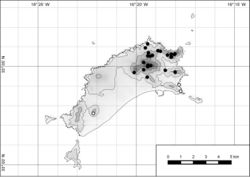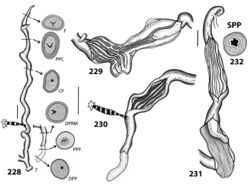Callina
| Notice: | This page is derived from the original publication listed below, whose author(s) should always be credited. Further contributors may edit and improve the content of this page and, consequently, need to be credited as well (see page history). Any assessment of factual correctness requires a careful review of the original article as well as of subsequent contributions.
If you are uncertain whether your planned contribution is correct or not, we suggest that you use the associated discussion page instead of editing the page directly. This page should be cited as follows (rationale):
Citation formats to copy and paste
BibTeX: @article{Mattia2018ZooKeys, RIS/ Endnote: TY - JOUR Wikipedia/ Citizendium: <ref name="Mattia2018ZooKeys">{{Citation See also the citation download page at the journal. |
Ordo: Stylommatophora
Familia: Geomitridae
Name
Callina R. T. Lowe, 1855 – Wikispecies link – Pensoft Profile
- Helix (Callina), Wollaston (1878)[1].
- Helix (Tectula), sensu Albers (1854)[2] and Paiva (1867)[3], partim.
- Geomitra (Actinella (Callina)), Pilsbry (1893–1895)[4], partim.
- Discula (Callina), Mandahl-Barth (1950)[5], Seddon (2008)[6] and Bank et al. (2002)[7].
- Callina, Waldén (1983)[8] and Schileyko (2005)[9].
Type species
Helix [Helicella] rotula R. T. Lowe, 1831 by monotypy.
Description of the genus
. Shell. The shell is dextral, solid, hairless, and it is usually discoidal to tectiform in shape. The protoconch is dark brown, with 1.4 to 1.9 whorls. It is almost smooth along the first whorl and shows radial striae along its remaining portion. The teleoconch has from 5.3 to 6.6 rapidly increasing whorls. It is corneous brown in colour on the upper side, mottled with scattered, light-brown small areas. One chestnut band is visible along the last three whorls. On the underside of the last whorl two brown bands are visible. The extent of these bands can be variable, either both of them very thin or the peripheral band very broad. Sometimes a number of thinner additional bands are present next to the main peripheral band or, less frequently, no bands are present at all on the underside of the last whorl. The peri-umbilical area is usually the lightest in colour. The spire is broadly conical, making the shell appear discoidal to tectiform. The periphery of the last whorl is either keeled, angled or rounded. The keel is often very distinct and may be slightly bend downwards. The keel is usually lighter in colour than the remaining surface of the whorls, being light brown to whitish. The external upper surface has very fine but clearly visible, relatively regularly spaced growth lines. Regularly disposed, very small, drop-like tubercles are present all over the teleoconch, especially along the growth lines. The dimensions of the tubercles remain quite stable along the whorls and also their density is approximately the same on all teleoconch whorls. The underside of the last whorl is also equipped with tubercles. The last whorl is only slightly wider than the penultimate whorl, and only slightly descending near the aperture. The umbilicus can either be completely closed or widely open (up to 1/5 of the maximum shell diameter). The aperture is elliptical. The lower palatal side of the last whorl shows a strong callous immediately behind the aperture or none. The peristome is interrupted along the palatal area, and it is only slightly reflected along the lower section. The palatal area never shows any kind callosities or thickenings.
Body. Very similar to Wollastonia gen. n. Head and neck are usually grey to dark grey. The sides and the posterior upper section of the foot are whitish to grey. The foot is whitish and the sole is longitudinally divided into three areas. The central area is smooth, whereas the two lateral portions are equipped with bands of muscles that are roughly arranged in a chevron pattern. The mantle border is dark grey, with five more or less well-developed lobes. In some specimens, one of these lobes (either lateral or dorsal) may be totally missing. The walls of the pallial cavity are colourless without any stripes or spots. A strong pulmonary vein is visible. The right ommatophoral retractor is independent from both penis and vagina.
Genitalia. The general arrangement of the genitalia is semi-diaulic monotrematic. A convoluted hermaphroditic duct arises from the gonad. The albumen gland is long and thin and connected to an approximately twice as long sperm-oviduct that consists of a prostatic and a uterine portion. The prostatic part extends to a thin vas deferens, which is approximately twice as long as the sperm-oviduct and which is terminating in the penial complex. The distal portion of the uterine part extends into the free oviduct, which transforms into a vagina at the level of the duct of the bursa copulatrix. The free oviduct is approximately as long as the vagina. The duct of the bursa copulatrix is very wide, approximately as long as the penial complex and usually uniform in diameter. It ends with an oval bursa copulatrix. The transition area between the duct and the bursa itself is not sharply delimited but rather gradually widens. The spermatophore is unknown. One tuft of digitiform glands arises from the proximal part of the vagina. There are usually two, equally long and very rarely branched glands present. A vaginal appendix arises from the vagina’s wall, just distal of the glandular tuft. Very smooth, rather wide, and little elevated, irregularly spaced pleats run longitudinally along the inner surface of the vagina, which reach into the genital atrium but not as far as the genital orifice. The atrium is short and wide. Its internal walls are smooth. The penial complex consists of a flagellum, an epiphallus (which extends from insertion of the vas deferens to the penial retractor muscle) and a penis that inserts into the genital atrium. The penial flagellum is short, cylindrical and with a pointed apex. It is usually ¼ as long as the epiphallus. Its internal walls are completely smooth. The epiphallus is usually ⅓ longer than the penis. Its internal walls are equipped with 20–25 very fine, elevated, longitudinal pleats. The retractor muscle is strong and approximately half as long as the epiphallus. The penis lacks any muscular or glandular sheath. It is extremely thick-walled and approximately ⅔ as long as the epiphallus. It is cylindrical and slightly swollen in its distal portion. The inner walls of the penis are smooth. The section where the rather large penial papilla is located is usually detectable from outside by virtue of a circular swelling corresponding to the origin of the papilla itself. The penial papilla is approximately half as long as the entire penis. It is conical to subcylindrical in shape and has smooth external walls, with an apically emerging opening. The channel of the penial papilla is thin and narrow. The inner lumen of the penial papilla is occupied by a spongy and sturdy tissue which directly connects with the walls of the epiphallus. The longitudinal section of the penial papilla (Fig. 226) shows that its walls are the continuation of the penial walls that abruptly bend inwards. See also Schileyko (2005)[9].
Jaw and radula. The jaw and the radula of Callina are very similar to those of Hystricella and Wollastonia. Only the number of the lateral and marginal teeth may be slightly higher: 21 to 29. They do not differ markedly from each other, i.e. their shape gradually changes from the first laterals towards the marginals. The jaw is odontognathous and very variable in shape, from almost straight to markedly arched. There are many smooth transverse ridges, ranging from 9 to 10 in number. For jaws and radulae of Callina species, see Figs 205–207.
Distribution
The genus Callina is endemic to the Island of Porto Santo (Madeiran Archipelago, Portugal). It is distributed along the central-eastern area of the main island. It is not present on the offshore islets. It is only present east of the line Vila Baleira-Dragoal-Camacha-Porto de Salemas. For distributional maps of Callina species, see Figs 204, 214, 217 and 224.
Taxonomic remarks
The results of the phylogenetic analyses indicate that Callina is not closely related to Discula R. T. Lowe, 1852 s. lat. as previously supposed but represents a well-supported clade that is closely related to Hystricella and Wollastonia gen. n. The taxon was already elevated to generic rank by Waldén (1995) and Schileyko (2005)[9], although without providing strong morphological evidence for this decision. An isolated position of C. rotula within Discula s. lat. was supposed by these authors on the basis of a closed (or “dot-like” following Schileyko, 2005: 2018) umbilicus. However, our morphological (genitalia) and genetic investigations showed that the closed umbilicus of C. rotula cannot be used as a discriminating feature at the genus-level as the widely umbilicated species C. bulverii also belongs to Callina as supported by the phylogenetic analyses and the peculiar arrangement of pleats on the inner wall of the epiphallus that is equipped with 20–25 very fine, elevated longitudinal pleats (Fig. 211). Contrarily, both Discula s. str. and Discula (Mandahlia) have an epiphallus with 5–7 strong and rather elevated, longitudinal pleats (Figs 228–230). The penial papilla of Callina (Fig. 211 and Fig. 225) always reaches the genital atrium, whereas in Discula s. str. and Discula (Mandahlia) the penial papilla is much shorter and never reaches the genital atrium (Figs 228–229). Discula (Mandahlia) has a very long epiphallus, at least three times longer than the penis (Fig. 230).
Taxon Treatment
- Mattia, W; Neiber, M; Groh, K; 2018: Revision of the genus-group Hystricella R. T. Lowe, 1855 from Porto Santo (Madeira Archipelago), with descriptions of new recent and fossil taxa (Gastropoda, Helicoidea, Geomitridae) ZooKeys, (732): 1-125. doi
Images
|
Other References
- ↑ Wollaston T (1878) Testacea Atlantica or the land and freshwater shells of the Azores, Madeiras, Salvages, Canaries, Cape Verdes, and Saint Helena. Reeve, London, 588 pp.
- ↑ Albers J (1854) Malacographia Maderensis sive enumeratio molluscorum quae in insulis Maderae et Portus Sancti aut viva exstant aut fossilia reperiuntur. Cum XVII tab. color. lapide incis. Reimer, Berolini, 94 pp. [17 pls]
- ↑ Paiva C (1867) Monographie molluscorum terrestrium fluviatilum, lacustrium insularum maderensium. Memorias da Académia Real das Sciências de Lisboa, Classe de Sciências Mathemáticas, Physicas e Naturaes (N. S.), 6(1): I–XIX, 1–168, 1–2, [pls 1–2]
- ↑ Pilsbry H (1893–1895) Guide to the study of Helices (Helicidae, Vol. 7). In: Tryon GW, Pilsbry HA (Eds) Manual of Conchology. Structural and Systematic. Second Series: Pulmonata. Vol. IX. Conchological Department, Academy of Natural Sciences of Philadelphia, Philadelphia, 1–48, pls 1–14 (November 16 1893), 49–112, pls 15–28 (March 19 1894), 113–160, pls 29–40 (July 27 1894), frontspiece, i–xlviii, 161–366, pls 41–71, (February 2 1895), index 1–126 (April 1895).
- ↑ Mandahl-Barth G (1950) Systematische Untersuchungen über die Heliciden-Fauna von Madeira. Abhandlungen der senckenbergischen naturforschenden Gesellschaft 469: 1–93.
- ↑ Seddon M (2008) The landsnails of Madeira. An illustrated compendium of the landsnails and slugs of the Madeiran archipelago. Biotir Reports 2: 1–196.
- ↑ Bank R, Groh K, Ripken T (2002) CLECoM Project. Catalogue and bibliography of the non-marine Mollusca of Macaronesia. In: Falkner M Groh K Speight M (Eds) Collectanea Malacologica. Festschrift für Gerhard Falkner. Friedrich-Held-Gesellschaft & ConchBooks, München & Hackenheim, 89–235.
- ↑ Waldén H (1983) Systematic and biogeographical studies on the terrestrial gastropoda of Madeira. With an annotated Check-list. Annales Zoologici Fennici 20: 255–275.
- ↑ 9.0 9.1 9.2 Schileyko A (2005) Helicodontidae, Ciliellidae, Hygromiidae. Ruthenica, suppl. 2: Treatise on recent terrestrial pulmonate mollusks, part 14: 1907–2047.
- ↑ Lowe R (1831) Primitiæ faunæ et floræ Maderæ et Portus Sancti; sive species quædam novæ vel hactenus minus rite cognitæ animalium et plantarum in his insulis degentium breviter descriptæ. Transactions of the Cambridge Philosophical Society 4(1): 1–70. [pls 1–6]

![Figures 205–209. 205, 206 radula and jaw of Callina rotula from Ribeira da Areia 207 radula and jaw of Callina bulverii 208 original figure of Helix rotula R. T. Lowe, 1831 (from Lowe 1831[10]: pl. 6 fig. 10) 209 lectotype of Callina rotula, ANSP 97116. Scale bar 1 mm.](https://species-id.net/o/thumb.php?f=Zookeys-732-001-g060.jpg&width=250)




